Tower Hopping in Japan
By Rey Waters
ITWPA MemberFor those who like breathtaking views, but don’t want to climb Mt. Fuji, try tower hopping!
Every major city in Japan has a tower with an observatory. During our past two Japan trips we visited six unique towers. The prices range from 600 yen ($7.75) to 820 yen ($10.50) to ride to the top. All are easily reached via train and/or bus.
Kobe, scene of the devastating 1995 earthquake, has a tower (302 feet) at its port located in Meriken Park. Even on a cloudy day it is still a worthwhile view. The tower was built in the shape of a tsuzumi (a traditional Japanese musical instrument). On the observatory floor is a rotating café and of course a gift shop. In the distance you see the Rokko mountain range and up close the skyline of Kobe. On a clear day we were told you can see the city of Osaka.
In Osaka (Japan’s third largest city) there are two towers. The floating garden tower (558 feet) is located at the Umeda Sky Building in Kita-ku business district (North Osaka). The building is recognizable due to the bridge connecting its two 40-story towers. Take the elevator and then the escalator to the rooftop observatory. In the basement of this building is an underground market built to resemble old Osaka, and you can enjoy one of the many great coffee shops found throughout Japan.
A taxi ride took us to the Shinsekai area (traditional old Osaka) and Tsutenkaku tower (338 feet). This one was patterned after the Eiffel Tower. We observed a completely different view of the city. On the fifth floor of the observation tower is the Billiken statue (God of Happiness). Touch his feet for good luck.
The Kyoto tower (433 feet) is the tallest building in the city, right across the street from the train station. You can see the many historical shrines throughout the area.
Yokohama Marine tower at 358 feet has a two-floor observation deck and a beautiful view of the harbor. Yokohama was the first area in Japan to open trade to the outside world.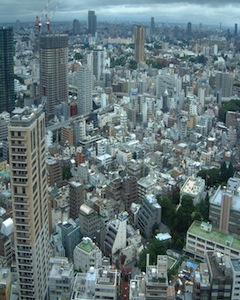 Of course there is the famous Tokyo tower, the world’s tallest self-supporting steel tower (1,091 feet), found in the Minato district of Tokyo. The view leaves you awestruck as to how many people live in this huge city.
Of course there is the famous Tokyo tower, the world’s tallest self-supporting steel tower (1,091 feet), found in the Minato district of Tokyo. The view leaves you awestruck as to how many people live in this huge city.
There are many more towers throughout Japan and our desire is to visit them all. The newest is the Tokyo Sky Tree, which will open in spring 2012. It is located in the Sumida Ward. The tower is 2,735 feet, making it one of the tallest in the world.
This is an inexpensive way to get a high-up view of the great cities of Japan.
If you’d like to purchase this article for your publication, click here to contact the author directly.
Additional photos available upon request.
 A sleek, dark black body suddenly appears, gliding silently, effortlessly, close enough to touch. Just as quickly it’s gone. Another appears. The narrow, pointed head, small ears, bull neck, and powerful flippers are huge in the crystal clear, tepid water. The sea lion’s large brown eyes look directly at me as it rolls, dives, and frolics with dolphin-like antics.
A sleek, dark black body suddenly appears, gliding silently, effortlessly, close enough to touch. Just as quickly it’s gone. Another appears. The narrow, pointed head, small ears, bull neck, and powerful flippers are huge in the crystal clear, tepid water. The sea lion’s large brown eyes look directly at me as it rolls, dives, and frolics with dolphin-like antics. 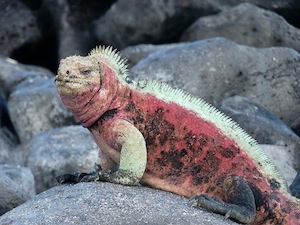 On land the same diversity and friendliness greet us. Many animals are endemic to specific islands. The three-foot-long red and green Marine Iguana (from the dinosaur age) are so plentiful and tame there is a real danger of stepping on them. They have a gland in the head that separates the salt from seawater so they can drink seawater. Occasionally they sneeze out the salt.
On land the same diversity and friendliness greet us. Many animals are endemic to specific islands. The three-foot-long red and green Marine Iguana (from the dinosaur age) are so plentiful and tame there is a real danger of stepping on them. They have a gland in the head that separates the salt from seawater so they can drink seawater. Occasionally they sneeze out the salt. We’re on board the 46-foot sailing catamaran “Galapagos Vision” with nine passengers, a crew of five, and our guide. The Galapagos Islands straddle the equator. It’s hot, 105 degrees. There’s no wind so we can’t use the sails. The sea is flat. We keep cool by snorkeling twice a day or just jumping overboard. We travel at night between islands and arrive each morning in a new place. Sometimes there are six to eight other tourist boats anchored in the same bay, some with over 100 passengers!
We’re on board the 46-foot sailing catamaran “Galapagos Vision” with nine passengers, a crew of five, and our guide. The Galapagos Islands straddle the equator. It’s hot, 105 degrees. There’s no wind so we can’t use the sails. The sea is flat. We keep cool by snorkeling twice a day or just jumping overboard. We travel at night between islands and arrive each morning in a new place. Sometimes there are six to eight other tourist boats anchored in the same bay, some with over 100 passengers!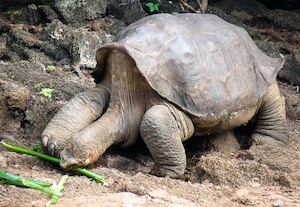 Our five-day trip ended on the island of Santa Cruz where the Charles Darwin Station is located. Sea lions once again line the footpaths. The very successful giant tortoise recovery program at the Darwin Centre has been operating for 30 years now. We visit the sad-looking “Lonesome George,” the 100-year-old last surviving member of his giant tortoise species.
Our five-day trip ended on the island of Santa Cruz where the Charles Darwin Station is located. Sea lions once again line the footpaths. The very successful giant tortoise recovery program at the Darwin Centre has been operating for 30 years now. We visit the sad-looking “Lonesome George,” the 100-year-old last surviving member of his giant tortoise species.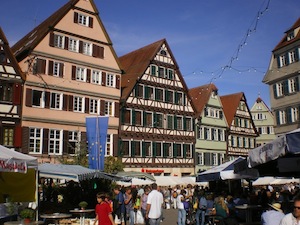 When I started my university career, little did I know it would take me to a picturesque town in the middle of the German state of Baden-Württemberg. But where better to spend my semester abroad; it is gorgeous and warm in summer while beautiful and white in winter, and the people defy just about every stereotype you have ever heard about Germany.
When I started my university career, little did I know it would take me to a picturesque town in the middle of the German state of Baden-Württemberg. But where better to spend my semester abroad; it is gorgeous and warm in summer while beautiful and white in winter, and the people defy just about every stereotype you have ever heard about Germany.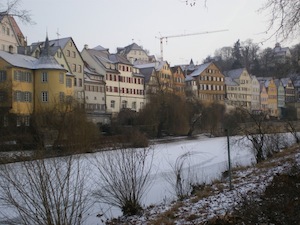 On the southern side of the Old Town runs the Neckar River, which together with Neckar Island forms the most commonly photographed part of Tübingen. A popular pastime in Tübingen is riding on the Stocherkahn (punting boats), and there is an annual punting race on the river each June. Another novelty race held on the Neckar River is the rubber duck race, in which thousands of yellow rubber ducks are let loose on the river, competing for first place and a prize. It is also on the northern bank of the Neckar River that we find the Hölderlinturm, where the poet Friedrich Hölderlin lived for the 36 years before his death after he was brought to Tübingen for ongoing treatment of mental illness.
On the southern side of the Old Town runs the Neckar River, which together with Neckar Island forms the most commonly photographed part of Tübingen. A popular pastime in Tübingen is riding on the Stocherkahn (punting boats), and there is an annual punting race on the river each June. Another novelty race held on the Neckar River is the rubber duck race, in which thousands of yellow rubber ducks are let loose on the river, competing for first place and a prize. It is also on the northern bank of the Neckar River that we find the Hölderlinturm, where the poet Friedrich Hölderlin lived for the 36 years before his death after he was brought to Tübingen for ongoing treatment of mental illness. To the north and northeast of the Old Town we find the university and university residences, as well as residential buildings. South of the Neckar River is the train station and an extension of the shopping in the Old Town, and slightly to the southwest is a large outdoor water park alongside sport facilities and a large grassy reserve area. There are also many nearby towns to explore, as well as castles and the Bebenhausen Monastery. For such a small town on a world scale, you will struggle to run out of things to do in Tübingen and its surrounding areas.
To the north and northeast of the Old Town we find the university and university residences, as well as residential buildings. South of the Neckar River is the train station and an extension of the shopping in the Old Town, and slightly to the southwest is a large outdoor water park alongside sport facilities and a large grassy reserve area. There are also many nearby towns to explore, as well as castles and the Bebenhausen Monastery. For such a small town on a world scale, you will struggle to run out of things to do in Tübingen and its surrounding areas.